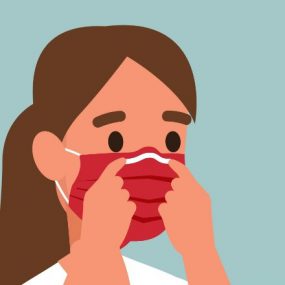A group of researchers recently created one of the most comprehensive fluid-dynamics model of SARS-CoV-2 transmission yet. The model has revealed that FFP2 masks offer the most protection from SARS-CoV-2. The model also suggests that if everyone wears an FFP2, the need for social-distancing becomes markedly reduced.
Researchers used the model to calculate exposure and infection risk under various conditions. Conditions include one-to-one interactions where persons do not wear a face mask but follow social-distancing, one person wears a mask, or both wear masks. The scenarios where people only followed social distancing (1.5m) quickly became unsafe. According to the model, after spending about 1.5 minutes with an infected person 1.5 meters away, your chances of getting COVID-19 jumps to 90% without masks.
When only you are wearing a surgical mask, the same scenario becomes unsafe after a minute and the risk of infection reaches 90% in an hour. This is in stark contrast with the scenario where both the infectious and the susceptible are wearing an FFP2 mask. In this scenario, the risk of infection remains below 1% even after an hour, an indication that masks, when worn universally, can dramatically reduce transmission.
FFP stands for 'filtering facepiece'. According to European standards, a face mask that is designated 'FFP2' filters at least 94% of particles that are 0.3 microns in diameter or larger. An FFP1 mask filters at least 80%, an N95 filters at least 95%, and an N99 or FFP3 filters at least 99% of particles.
The study also found that besides the filtration capacity of the mask, the mask’s fit to the wearers face is a crucial factor that determines the risk of infection. Several masks have a nose wire to prevent air leakage at the top of the mask. Adjusting this nose wire on an FFP2 mask (when done by both A and B) was shown to decrease risk of infection by a factor of 30!

The model also found that very loosely fitted FFP2 masks outperform adjusted surgical masks by a factor of 2.5. Compared to a surgical mask, the protection offered by an FFP2 mask is x75 greater, the study revealed.
“When both infectious and susceptible wear FFP2 masks, that is, a reduction in the risk of infection by a factor of ∼ 75 is expected compared with the case where both wear surgical masks.”
The model considered many factors to arrive at it’s conclusions – particle size distribution; exhalation flow physics; leakage from face masks of various types and fits measured on human subjects; consideration of ambient particle shrinkage due to evaporation; and rehydration, inhalability, and deposition in the susceptible airways.
Normally, a transmission model has to account for several factors that influence the transmission viral particles from person A to person B. This includes temperature, airflow in the room, type of ventilation etc. These factors vary quite a bit in real life. For the model however, researchers used the “upper bound”. This is the highest-risk condition in which these factors are most conducive to transmission.
According to the researchers, “the main idea behind the upper bound is that, if a scenario proves to be safe under the upper bounds, there is no question of its effectiveness under real conditions.”
Read more about the study by Gholamhossein Bagheria, Birte Thiedea, Bardia Hejazia, Oliver Schlenczeka, and Eberhard Bodenschatz here.








